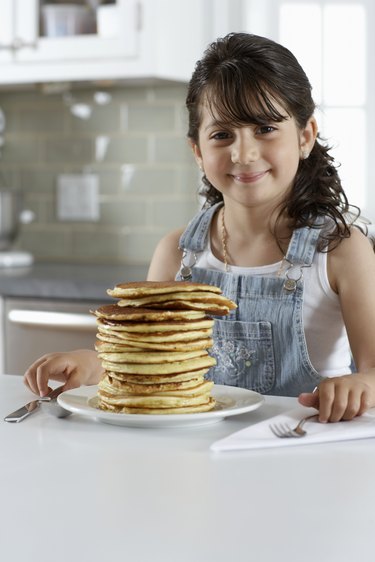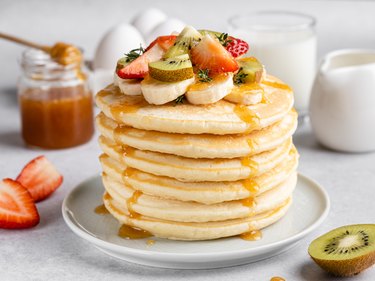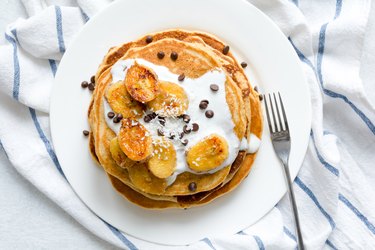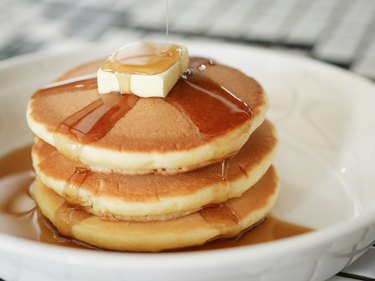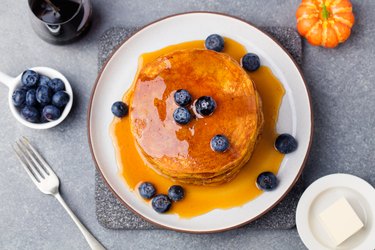
Nothing ruins a perfect breakfast like a pancake that gets stuck to the pan. While there isn't necessarily a "nonstick pancake recipe," there are a few steps you can take to prevent your pancakes from getting stuck. You'll be cooking non-stick pancakes in no time!
Things You'll Need
Nonstick frying pan
Paper towel
Vegetable or canola oil
Butter
Pancake batter of your choosing
Video of the Day
Step 1: Choose Your Pan
Get out a nonstick frying pan — the best type of pan for pancakes. Nonstick pans boast a special coating that helps to prevent food from sticking to the pan during cooking.
Video of the Day
Heavy pans work better for cooking pancakes that don't stick. Thin pans can heat unevenly, causing pancakes to stick to their surfaces even if they have a nonstick coating.
Do not use metal implements on your nonstick pan to avoid scratching the coating, which can result in food sticking to the scratched area. Choose wooden or plastic utensils, as advised by Iowa State University.
Step 2: Rinse and Dry
Rinse and dry your frying pan before getting started. Even if you previously washed the pan, remaining food residue that you cannot see can and will make your pancakes stick.
Step 3: Coat With Oil
Dip a paper towel in vegetable or canola oil and wipe the bottom and sides of the pan with the dampened paper towel until the pan has a light sheen of oil.
Step 4: Turn on the Burner
Place the pan on the stove and set the burner to medium-high.
Step 5: Test the Temperature
Test the pan after several minutes to ensure that it's hot enough by wetting your hand and flinging several drops of water onto the pan's surface. In a properly heated pan, the drops of water will bead up and sizzle before disappearing. A hot pan slightly sears the outside of each pancake, preventing the batter from sticking to the pan.
Step 6: Add Some Butter
Drop a small spoonful of butter into the pan. This provides your pancakes with a rich, buttery flavor while simultaneously lubricating the pancakes and preventing them from sticking to the pan. Allow the butter to melt completely.
The amount of butter you will need will vary significantly, depending on the size of the pan. The larger your pan, the more butter you will need. Pancakes soak up butter while they cook. If you plan on making a large batch of pancakes, periodically add more butter to the pan.
Butter contains a significant amount of unhealthy saturated fats — 7 grams per tablespoon, according to the USDA. Saturated fats can contribute to heart disease, according to the American Heart Association, so you should aim to eat less of them. While normally substituting a cooking spray would be a smart move to reduce fat intake, Iowa State University advises against aerosol sprays when cooking with nonstick pans. The spray has the potential to damage the coating on the pan that makes it nonstick in the first place.
Step 7: Cook Your Pancake
Pour the pancake batter into the pan until your pancake reaches your desired size. Cook the pancake.
Wait until the pancake's edges begin to bubble before flipping it. Bubbling edges signify that the bottom of the pancake has solidified. Turning the pancake too early not only makes a mess, but also increases the risk that your pancake will stick to the pan.
Other Tips to Avoid Pancake Sticking
Maybe you prefer to cook pancakes with you cast iron, or maybe you don't have a nonstick pan available. Whatever the reason, it is possible to avoid pancake sticking with a standard frying pan, so check them out below. Even if you are using a nonstick pan to cook your pancakes, these nonstick pancake tricks may come in handy. Some sticking solutions to consider:
If you're cooking pancakes with an ordinary pan, be sure to thoroughly grease up the pan with either butter or oil. Allow the ingredient to get hot before adding your batter.
If your pancake is sticking to your nonstick pan, it's possible that it's actually sticking to residue inside the pan, according to Iowa State. This residue can be leftover from oils you cooked with your last meal — these can sometimes be tough to clean off. To make sure your pan is extra clean, Iowa State University advises soaking the pan in hot water and dish soap, and scrubbing the pan with a non-abrasive sponge.
